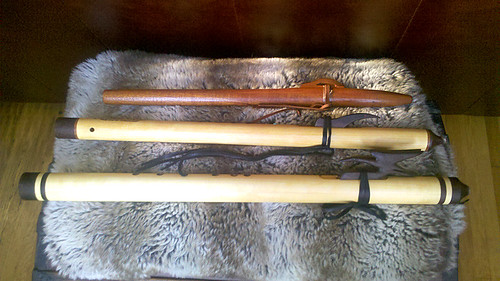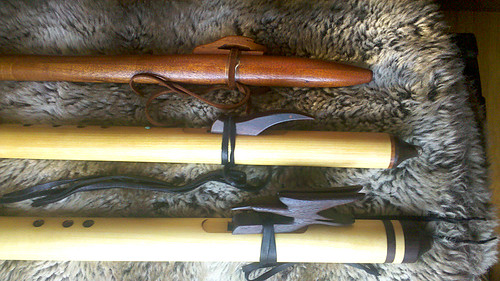Rather than go through every possible pairing of keys there are a couple very simple ways to figure this out no matter what key your flutes are in.
What keys work best
If you want to play duets, trios, or even quartets, with other flute players the keys of all the flutes need to be related somehow. Keys that are related keys share more notes than unrelated keys and therefore will sound better.
When choosing flutes to play duets with the first step is to pick one NAF as the master, thereby establishing the master key from which to choose other flutes. Once you’ve done this the rest becomes fairly easy. For this post I will also call the master flute: Flute-#1.
In general, to avoid playing too much cross fingering, there are three keys that work the best when picking one to harmonize with Flute #1: The same key, the key a fifth above the master flute, and/or the key a fourth above the master flute.
While this may sound hard, it’s not. Let's start with two flutes a 5th apart.
Finding NAFs a 5th apart
Once you have picked a flute to be Flute-#1, your master flute, you need to figure out what pitch a 5th on that flute is. If you don't know the note names in that key, here's an easy way to locate that pitch you're looking for.
| The root of your master flute (Flute-#1) no matter what key you choose, will be fingered like this: |  |
| To find the 5th on the master flute play this fingering: |  |
| To look at it another way, the pitch produced by playing this fingering on the master key flute... |  |
| ...will be the same pitch as produced by this fingering on a NAF a 5th higher. |  |
|---|
This only refers to this one pitch. We will look at how the the scales mesh later in this post.
Here are some common NAF keys that are a 5th apart:
F# - C#, G - D, A - E.
All of these pairs can be in any register. So if you don’t have a high E but do have a mid range E, or even a Bass E it will still work with a flute in the key of A. However, as a general principle, having the flute that is in your master key (Flute-#1) play in a lower register will sound better if you’ve never done this before.
Why This Sounds Good: 5ths
The reason why flutes sound good in these pairing is due to the amount of notes they share. For example flutes that are a 5th apart share all but one note
| Key=G | G | Bb | C | D | F | G | - | - | - |
|---|---|---|---|---|---|---|---|---|---|
| Key=D | - | - | - | D | F | G | A | C | D |
Out of the six notes available in each NAF's basic scale, four of them can be played by both flutes without any cross fingering.
If we include the note, as shown fingered below, on the second NAF (the one a 5th higher) we can now play the minor 3rd from the master flute on the higher flute. In the example above this would be the Bb flat from the master flute in G, but played on the flute in D. So now we can play that pitch on both flutes! (This is the minor 6th on the flute a 5th higher, but you don't need to know this for it to work.)

Added note on the Flute-#2
Now both flutes can play five of the six total notes available between the two flute's basic scales.
Here's a sample of two NAFs a 5th apart
NAF Duet in 5ths by Cedar Mesa Music
To find out more about all the audio samples in this post be sure to read About the audio samples located at the bottom.
Finding NAFs a 4th apart
Now let's locate the note a 4th above the root of Flute-#1.
| Playing this fingering on your master flute... |  |
| ...will produce the same pitch as the root note on a flute a 4th higher |  |
Here are some common NAF keys that are a 4th apart: F# - B, G - C, A - D.
Why This Sounds Good: 4ths
Just like NAFs that are a 5th apart, NAFs whose keys are a 4th apart share a lot of notes. Out of 7 total pitches the two flutes share 5 of them. If you use all the notes between both flutes you can play a full diatonic natural minor scale starting on the root of Flute-#2, starting on a C.
| Key=G | G | Bb | C | D | - | F | G | - | - |
|---|---|---|---|---|---|---|---|---|---|
| Key=C | - | - | C | - | Eb | F | G | Bb | C |
When I play duets a 4th apart and am playing Flute-#2 I tend to not play the minor 3rd (the second note on a NAF) but just skip over it. I also like to add the major 6th, for a little spice, which you can get with this fingering

Added note on the flute #2
NAF Duet 4ths by Cedar Mesa Music
"Say What..."
Now let's get a bit clever. If you take a close look at the diagram that compares notes in the key of G and the key of C you might have already figured out that if two players decide that they would rather make the bottom note of Flute-#2 the tonic of the key they are playing in that will make the relationship between the two flutes a 5th.
How does this work, you may be asking? Scales in western music are not divided evenly in half. The bottom half of the scale is the interval of a 5th, while the top half is a 4th.
Therefore, if you and another NAF player decide to play flutes a 5th apart, but the flute used for Flute-#2 is lower than Flute-#1 you could say you are playing a 4th apart! What will determine whether the relationship between the two flutes is a 4th or a 5th is which note is functioning as the root for both flutes. In both of the audio samples in this post the lower flute, Flute-#1, has always played the master root note for both flutes. Therefore the higher flute, Flute-#2, has had to conform to the lower flute's key in each example.
Let's look at this another way. If the notes F# - B are a 4th apart, when you reverse them, B - F# they are now a 5th apart. Conversely if the notes F# - C# are a 5th apart, when you reverse them to C# - F# they are now a 4th apart.
About the Audio Samples
The audio samples were recorded with a Heartsongs flute in the key of D for Flute-#1. One track was used for both samples, e.g. they are the same recording. Above this are a Yazzie flute in A for the sample of two flutes a 5th apart and another Heartsongs flute in G for the sample of the flutes a 4th apart.
I chose to make the master flute, Flute-#1, in D to keep both the second flutes from being too high.


The Three Flutes
© Cedar Mesa Music, BMI. All rights reserved.